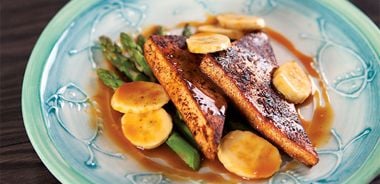Spicy Tofu with Zesty Banana-Orange Sauce

This tasty vegan meal takes only minutes to prepare, but its unique flavour combinations and exotic appeal will have your family thinking you’ve fussed for hours.
Tofu
1 Tbsp (15 mL) paprika
1 tsp (5 mL) ground cumin
1 tsp (5 mL) ground coriander
Salt and pepper to taste
12 oz (340 g) firm organic tofu, divided into 4 quarters or “steaks”
1 Tbsp (15 mL) extra-virgin olive oil or avocado oil
Sauce
1 cup (250 mL) orange juice
Zest of 1/2 orange
2 Tbsp (30 mL) coconut palm sugar or sucanat
2 large bananas, sliced on the diagonal into 1/2 in (1.25 cm) pieces
Add paprika, cumin, coriander, salt, and pepper to small bowl. Stir to mix.
Pat tofu dry with paper towels to remove any excess water. Rub some spice mix onto each tofu “steak,” pressing spice down into tofu with your fingers to make sure it adheres.
Heat oil on medium heat in frying pan. When oil is hot, add tofu steaks and cook on either side until tofu is nicely browned and crispy on both sides. While tofu is browning, make the sauce.
Place orange juice, zest, and coconut palm sugar in small saucepan. Cook over medium heat until sugar is completely dissolved and sauce starts to thicken somewhat.
Turn down heat and add sliced bananas. Remove from heat and let sauce stand for 2 minutes. Serve warm over sautéed tofu.
Makes 4 servings.
Each serving contains: 261 calories; 14 g protein; 11 g total fat (2 g sat. fat, 0 g trans fat); 31 g total carbohydrates (18 g sugars, 5 g fibre); 40 mg sodium
source: "Go Bananas", alive #376, February 2014




